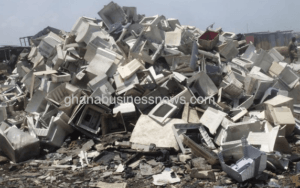Minister says Ghana e-waste plant to create 20,000 jobs, but silent on health and environmental issues
 Ghana is being overwhelmed in chemicals contained in electronics waste, commonly known as e-waste. Despite donor interest and support to address the potentially explosive – environmental and public health risks, government after government has played politics with the problem.
Ghana is being overwhelmed in chemicals contained in electronics waste, commonly known as e-waste. Despite donor interest and support to address the potentially explosive – environmental and public health risks, government after government has played politics with the problem.
When the Minister of Finance, Ken Ofori-Atta presented the 2019 budget to Parliament yesterday November 15, 2018, he mentioned that the country’s e-waste recycling plant yet to be built will create 20,000 direct jobs. He however, made no mention of plans to address the potential health and environmental hazards that e-waste poses to Ghanaians.
There is no known plan to clean up the contamination already in the system, if that was possible.
E-waste is the generic name for electronics waste. These are discarded electronics devices that come into the waste stream from several sources. They include gadgets like televisions, personal computers (PCs), telephones, air conditioners, cell phones, and electronic toys. The list can further be widened to include appliances such as lifts, refrigerators, washing machines, dryers, kitchen equipment or even aeroplanes.
The modes of disposal, which include dumping old gadgets into landfills or burning in smelters, also expose the environment and humans to a cocktail of toxic chemicals and poison.
And by the way, that project was launched by the previous government, but for the politics around it, construction should have started by now.
While at it, the environmental and health risks posed by the cancer causing agents in e-waste are now closer to many Ghanaians living in and around the e-waste processing centre in Agbogbloshie in Accra.
The dangerous chemical pollutants contained in e-waste are released into the atmosphere and underground water.
Multiple scientific studies conducted on soil and water collected from the sites have shown extremely high levels of carcinogenic substances such as lead, cadmium, barium and others, and these are spreading beyond the Agbogbloshie. The contamination has reached areas including James Town, Korle-Gonno and the Korle-bu Teaching Hospital.
These chemicals contain substances like lead, mercury and arsenic. The cathode ray tubes (CRTs) in most computer monitors and television screens have x-ray shields that contain four to eight pounds of lead, mostly embedded in glass.
Flat screen monitors that are mostly used in laptops do not contain high concentrations of lead, but most are illuminated with fluorescent lights that contain some mercury.
A PC’s central processing unit (CPU), the module containing the chip and the hard disk, typically contains toxic heavy metals such as mercury (in switches), lead (in solder on circuit boards), and cadmium (in batteries).
Plastics used to house computer equipment and cover wire cables to prevent flammability often contain polybrominated flame retardants, a class of dangerous chemicals. Studies have shown that ingesting these substances may increase the risk of cancer, liver damage, and immune system dysfunction.
Lead, mercury, cadmium, and polybrominated flame retardants are all persistent, bio-accumulative toxins (PBTs), that can create environmental and health risks when computers are manufactured, incinerated, landfilled or melted during recycling. PBTs, in particular are a dangerous class of chemicals that linger in the environment and accumulate in living tissues.
According to the Minister, the Integrated E-waste Management programme, which had been launched, would, among other things, ensure the management of e-waste in an environmentally sound manner and turn the challenges of e-waste management into green business opportunities.
The programme, he said, would lead to the creation of over 20,000 direct jobs through the establishment of a national e-waste recycling facility, associated holding centres in each regional capital and collection centres in each district.
The German government provided the $30 million for the project.
The presence of e-waste in Ghana’s waste stream came into public notice in 2007 following an explanatory article written by our Managing Editor. Following the publication of the article online, the international media followed up and did several reports on the issue drawing the attention of some Western governments, particularly the German government, which subsequently provided the funding for the construction of a recycling plant in the country.
It appears, there is very little interest in Ghana in the overall dangers that e-waste poses to the population. There isn’t enough public discussions of the problem.
While the country has passed the Hazardous and Electronic Waste Control Management Bill 2016 to regulate e-waste in the country and according to available information the levy on electronics items stipulated in the law was to come into force this November, there are no known structures in place to enforce the law.
In any case the global e-waste problem isn’t declining, as innovation and the speed in technological advancement and the addiction of humans to electronic devices is driving a wave of new devices which means users discard their devices for new ones quicker.
A new report by the United Nations University says in 2016, the world generated some 44.7 million metric tons of e-waste, of which only 20 per cent was recycled through appropriate means. According to the report: ‘The Global E-waste Monitor 2017’ released December 12, 2017, the amounts of e-waste in the world continues to grow.
By Emmanuel K. Dogbevi
Copyright ©2018 by Creative Imaginations Publicity
All rights reserved. This article or any portion thereof may not be reproduced or used in any manner whatsoever without the express written permission of the publisher except for the use of brief quotations in reviews.
